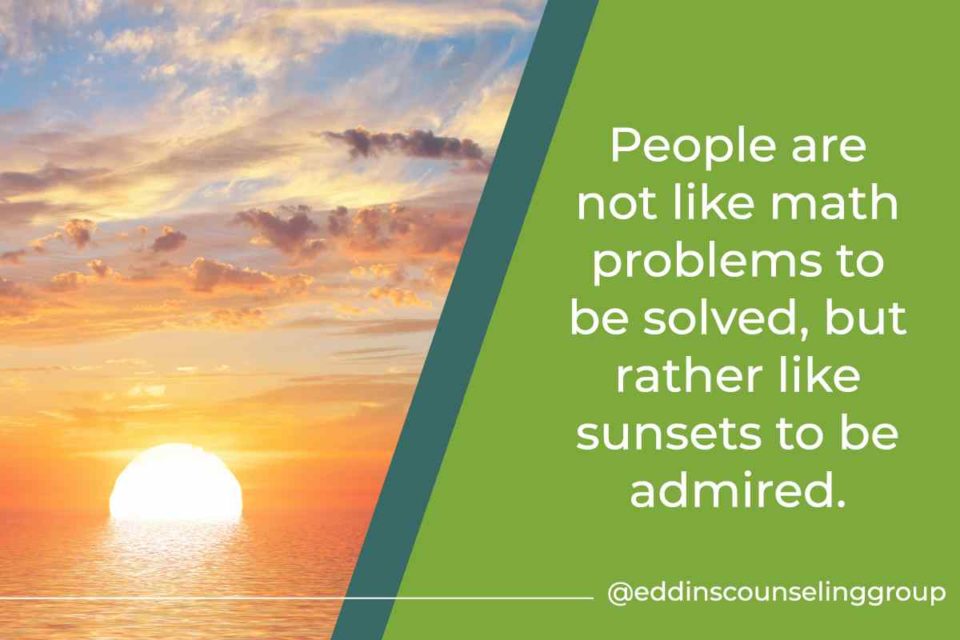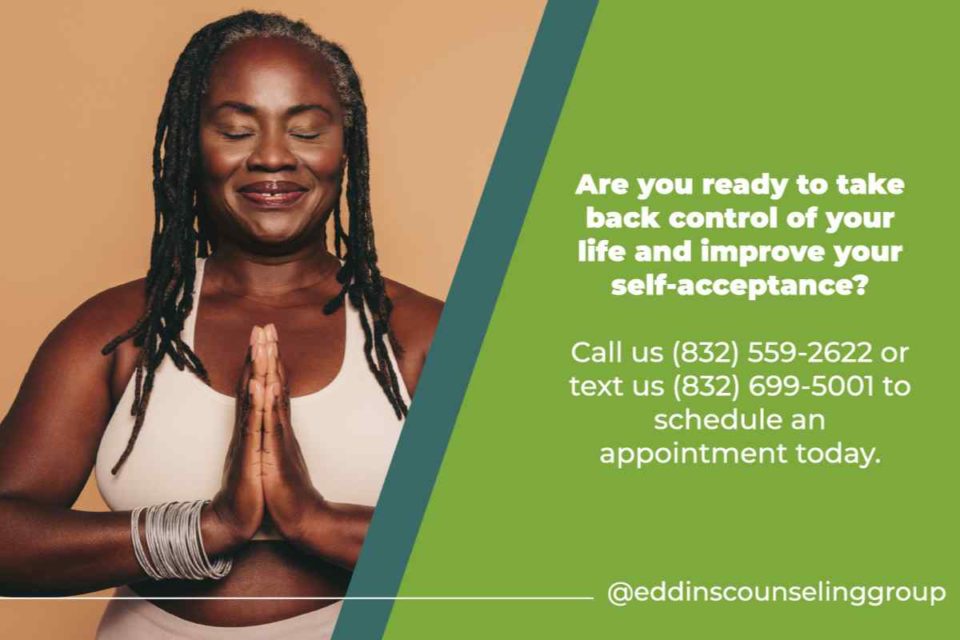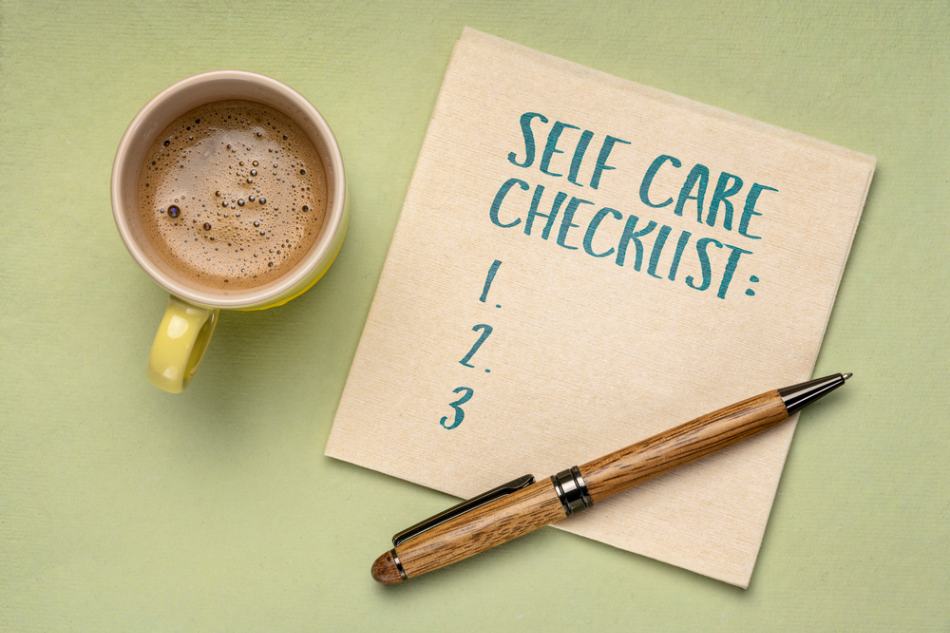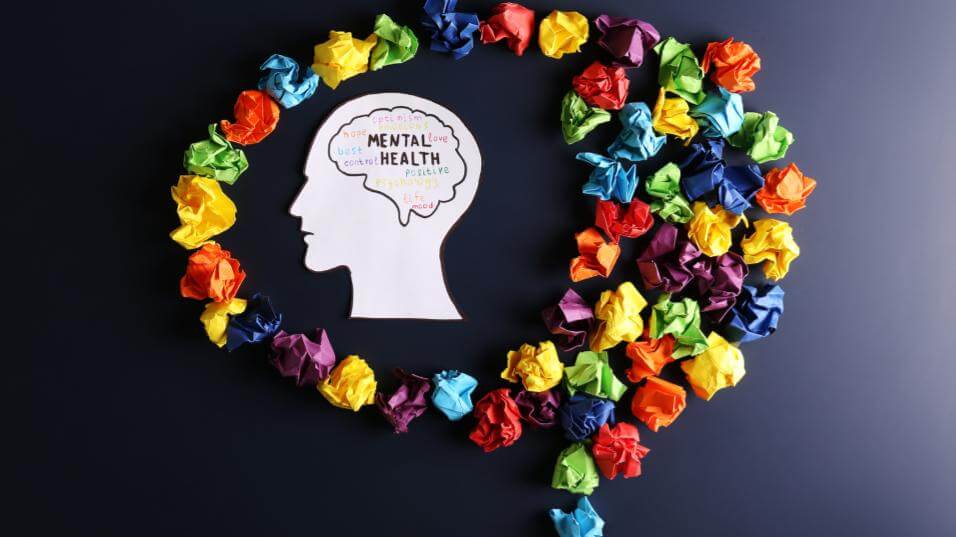February 6, 2023
How To Accept Yourself: 8 Truths You Need To Know To Be At Peace With Yourself
Written by Sara Lane
Posted in Self Help / Personal Development and with tags: self-compassion

It’s far too easy to feel as though you’re never good enough. Our licensed therapists in Houston, Montrose, and Sugar Land talk with clients everyday about how to accept themselves. In this article, our therapists help you discover eight tools you need for better self-acceptance.
If you’re like millions of other people around the world, accepting yourself is an ongoing process.
Even if you are surrounded by loving relationships, if the relationship you have with yourself is characterized by self-rejection – instead of self-acceptance – you can feel lonely and empty inside. It can feel like there’s a void.
Sometimes, that void can be filled with “too much” work, food, substances, video games, shopping, or obsessive thoughts.
When we’re trapped by self-rejection, it’s difficult to see the forest through the trees.
In today’s fast-paced world, we’re focused on:
- feeling better,
- changing something about ourselves,
- distracting ourselves, or
- numbing the pain
Instead, let’s focus on being able to see the goodness that is already within us and is our potential.
That’s why it’s important to make the most of every opportunity to love yourself – appreciating yourself for who you are.
Self-acceptance frees up our emotional energy to be directed towards more of what we truly value and desire in our lives.
This also frees up creative energy, which is very helpful in planning, problem-solving, and adapting to life’s challenges.
The reality is that we all already have a grand set of skills and talents. Practicing self-acceptance allows you to tap into those resources and use them for good.

Reasons We Reject Ourselves
Let’s walk through some of the most common reasons people give for rejecting themselves or judging who they are:
We feel we are broken…
As a culture, we are focused on “fixing it”. Making better grades, owning the best wardrobe, improving our romantic expressions.
However, the process of improvement doesn’t apply to ourselves and our emotions, just our engineering standards! When applied to ourselves, an ‘always could be better’ mindset leads us to constantly finding faults, what’s not good enough, what can be improved, done better, and even belittling ourselves.
What ends up happening is that we focus on the negative at the expense of acceptance.
When we take the same approach towards people vs. things/problems, it means we are in non-acceptance, which actually creates resistance and makes us less likely to change or move forward in a positive direction.
One helpful analogy to keep a positive perspective is this:
People are not like math problems to be solved, but rather like sunsets to be admired.
We are perfectly imperfect. Remember, appreciate the sunset as it is instead of what it could be.
Acceptance is scary…
For many people, acceptance feels REALLY scary.
You may be asking yourself, “If I accept myself, won’t I be resigned, and then nothing will change in my life?”
A common worry is that accepting ourselves will lead to being stuck, and things won’t get better or grow. Some worry that they’ll be stuck feeling negative emotions that they want to fix and get rid of.
In fact, counter-intuitively it’s the opposite:
When we operate from a place of acceptance, we free up all the negative energy that consumes thinking and behavior.
Instead, acceptance allows us to have greater access to our own internal resources, which can be used towards what REALLY matters to you, your important life values.

We believe that we really aren’t worth love or connection…
Most of us have one thing in common: we question whether we are worthy of love and connection.
From an adaptation theory perspective, we have an innate negativity bias. One way we survived was to be on the lookout for danger to keep ourselves safe from threats, enemies, or even death.
In our modern world, this translates to our brains constantly scanning for “what’s wrong.” Again, this means that we often overlook or disregard “what’s right.”
Instead of seeing yourself as a burden, think of all of the light and love you have to share. What a gift that is to a broken world! We’ll talk more about that later.
We never really felt accepted by others…
Many people feel that they aren’t connected or desired by the people around them.
For some, this lack of acceptance may have started in childhood. Perhaps your parents, teachers, caregivers, family members, or mentors couldn’t model self-acceptance.
This is not about blame – even the most loving, well-meaning people can only give as much as they have internally available.
Help is often thought of as “correcting something” since we are in a fix-it culture.
Regardless, messages that you’re too much of this or not enough of that lead to an internal self-rejection.
Rejection and shame can lead to faulty core beliefs that become established when we are young. These faulty beliefs might try to convince us that we are inadequate, unworthy, flawed, unlovable, and defective.
Sometimes the messages aren’t direct.
For example, a mom who is very different in personality and style from her daughter may reinforce the things that are similar to herself and politely reject the things that are different (eg. saying things like “we don’t do things that way / pay more attention to this, not that”).
This kind of talking screams the message: “The way you are is wrong. The way I am is right.”
This kind of judgment and rejection can be inherently painful, and harms the development of a healthy sense of self.
If you have experienced or communicated this form of self-rejection, there’s still hope.
What’s broken can be mended, but it’s important to first acknowledge that this kind of thinking is inherently flawed.

We don’t feel as pretty or cool as they are…
Societal expectations and standards often minimize our sense of innate worth.
If we don’t live up or measure up, we believe we have to hide parts of our bodies, personalities, and vulnerable selves and minimize our accomplishments (eg. it’s nothing compared to ________).
We see and hear these messages everywhere: obviously in advertising, but also in little ways.
Examples:
“Why can’t that mom better control her kids?” (message: She’s not good enough as a parent.)
“She’s quite large, she’ll never meet a man.” (message: She’s not good enough for love based on appearance.)
This leaves us with a discrepancy between who we are and who we think we should be.

Am I Truly Lovable & Enough?
To accept ourselves, we have to face the facts and see ourselves as we truly are: worthy of love and acceptance. Totally enough.
Try these eight ways that you can practice better self-acceptance:
1. Create Healthy Self-Talk
Practice having a compassionate, self-accepting inner dialog with yourself on a regular basis.
This is one of the most important and helpful things you can do to work on your self-acceptance.
Pay attention to negative thoughts that show up automatically. When they pop in your mind, stop and ask yourself “What am I feeling? What do I need?”
Then work on creating the self-accepting voice that validates you and provides what you need in that moment.
Examples:
I’m so stupid! I can’t do anything right!
Self-accepting voice: I hear that you’re feeling frustrated and inadequate and helpless. It makes sense that you’re feeling helpless, you’ve been working on this for so long and nothing seems to be working out right. It’s ok. I know how challenging this is right now, but I’ll help you get through it.
2. Acknowledge Your Pain
Sometimes things are just hard and that can be really frustrating.
You are capable. Remind yourself of the little wins — working hard on a project for work or school assignment, taking the trash out on time, potty training for a consecutive number of days.
What you’re doing is not easy, but you’re brave!

3. Allow Yourself to Rest
How about taking a break and letting yourself rest?
When you take a break and then return to your work, you might come back feeling refreshed and thinking more clearly. A step back can give your brain time and space to get creative… so give yourself permission to rest your mind.
To enhance this, Kristin Neff suggests adding physical touch for soothing. You can hold your arms, your heart, your face, whatever feels soothing and comforting.
The goal is not only to rewire your thoughts, but also to comfort and soothe your nervous system.
4. Practice Mindfulness
This is a commonly used word in psychology these days, but what it generally refers to is being fully present and aware of your thoughts, physical sensations, and emotions. It’s being in a state of open focus and awareness.
In a state of mindfulness, difficult thoughts and feelings have much less impact over you which makes it easier to move towards acceptance.
One of the reasons it’s difficult to practice mindfulness is because it involves taking time out of your busy day to be fully present.
This may feel impossible, but just a few minutes can make a big difference in your day.
5. Feel Your Feelings
Don’t be afraid to feel your emotions. They’re actually there to give you important information, even if it feels uncomfortable.
The more you can mindfully tune in to them and name them, the more likely you’ll get the message about what you really need.
For example, when you experience sadness (different from depression), it may be a sign there’s something you need to let go of. Letting go and allowing yourself to experience the sadness is what actually rejuvenates you.
Sometimes our lack of acceptance is the unwillingness to feel or experience uncomfortable emotions. Feeling physically heavy or unfit is a great example of this.
For example, a woman complains about feeling too big and explains that she cannot accept herself the way she is. In many of these cases, what is actually happening is that she’s feeling the “heaviness” of sadness and continuing to beat herself up perpetuates the negative feeling.
By getting in touch with that sadness and letting it go, you can move more easily towards acceptance.

6. Be All You
No matter the discontent you feel with yourself, don’t compromise your spark. Speak your authentic/vulnerable truths with someone you can trust.
What can often make it difficult to practice self-acceptance is the fear of judgment and/or shame. This fear can be automatic so we might not even be aware that it’s happening.
Shame shows up in avoidance behaviors, emotional eating, critical thoughts, fears, social anxiety, obsessions, etc. Just talking about some of the thoughts and feelings you are aware of can relieve that burden and make it easier to practice self-acceptance.
When it’s all bottled up inside it’s like a big, hairy, monster under the bed. when you say it out loud, sometimes it sounds even a bit silly and you realize it’s just the Oz behind the curtain.
You might respond to these feelings by acknowledging, “Of course I’m lovable!” Or, “Wow, that’s so sad. I can’t believe I’ve been telling myself that for years!”
This is actually one of the reasons talk therapy works. It helps clients relieve what’s built up inside.
Once you get things out of the darkness of your mind, you realize that those beliefs stem from situations or things you may have experienced, but not about the core of who you REALLY are.
Vulnerability specialist Brené Brown says:
‘The antidote to shame is to have the courage to speak your shame with someone who’s earned the right to listen.’
This means that you might not tell your co-workers about your sexual abuse history, but you rather choose someone closer to experience connection and support.
When we can repel shame, we can accept ourselves.

7. Shoot for the Moon & Land on the Stars
Adjust your expectations about what you can realistically achieve as well as for others. The unrealistic expectations can lead to self-rejection and keep us from self-acceptance.
8. Practice Forgiveness
This is the ultimate in compassion and self-acceptance. Forgiveness allows yourself to feel disappointments and uncomfortable feelings.
Use your compassionate inner voice to forgive. (“It’s ok. You’re only human.”)
You might be amazed at how much relief you will feel if you can actually move through this step. Generally, forgiveness is the last stage in the process after you’ve practiced the steps above.
Commit to practicing one of these exercises daily. It really will make a difference in your life, but it’s one that needs regular attention to create new neural pathways (a few minutes a day)!

Keep Being Wonderfully You
It’s far too easy to feel as though you’re never good enough. Our licensed therapists talk with clients about how to accept themselves every day.
In fact, our Houston therapists help you learn the tools you need to improve your self-acceptance.
If you are considering therapy, reach out to Eddins Counseling Group today to schedule an appointment.
Remember: You are loved and accepted…just as you are!
Why You Feel This Way
Get instant access to your free ebook.
Grounding & Self Soothing
Get instant access to your free ebook.
7 Mood-Boosting Tips
Get instant access to your free ebook.
















